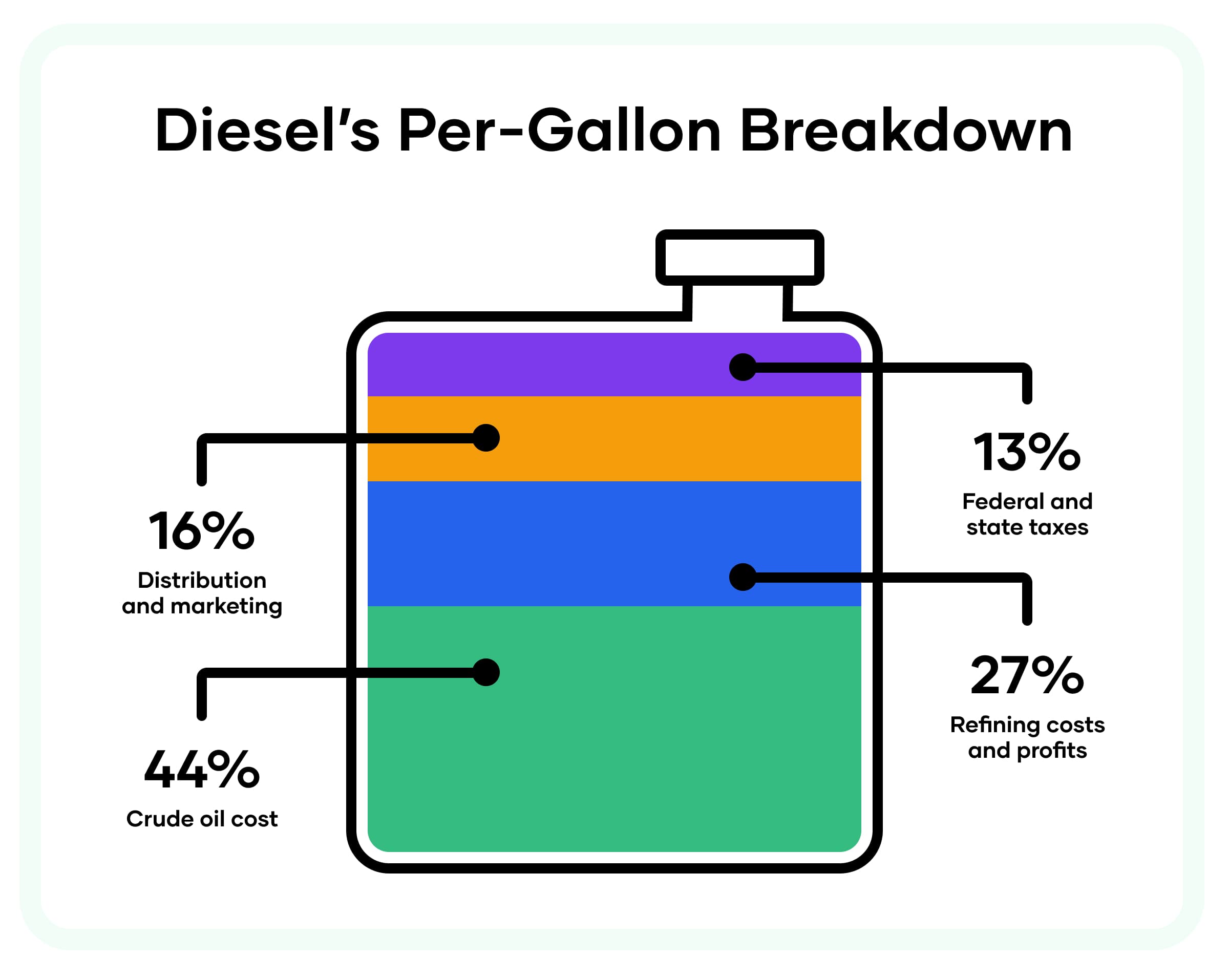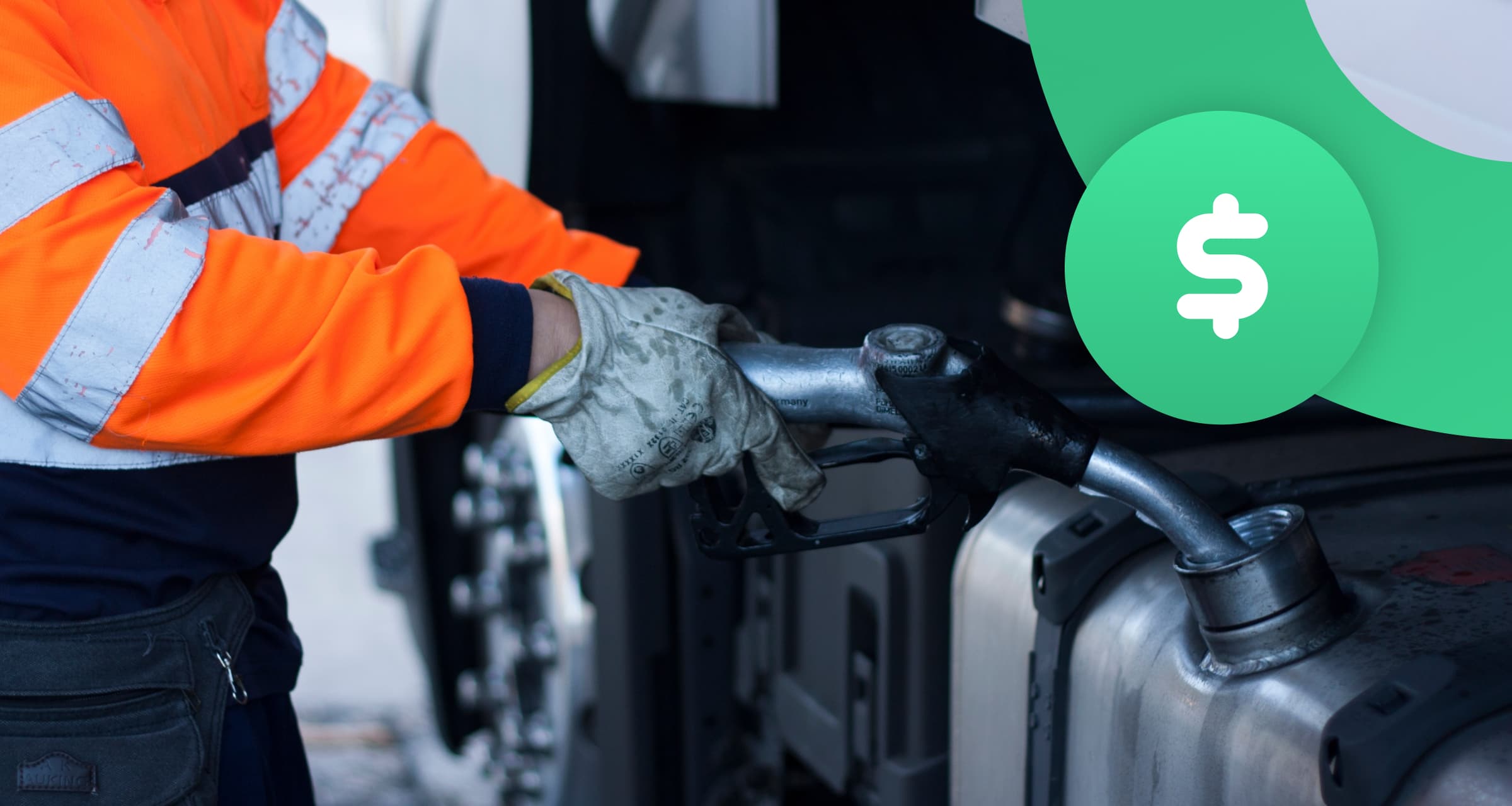Diesel fuel prices have had the whole transportation industry on a rollercoaster this past year. And while prices finally began to drop at the end of 2022, they’ve been inching higher consistently since mid-July. Unsurprisingly transportation professionals are paying even closer attention to diesel price fluctuations and trends, as they anxiously try to plan for the coming holiday season and year ahead.
Knowing what goes into the cost of every gallon can help truckers and carriers better understand what to expect. Here, we take a closer look at the costs comprising diesel’s price per gallon, the key factors affecting diesel prices, and some steps drivers and carriers can take to minimize their costs.
What goes into the cost of diesel
In the US, nearly all diesel fuel is used by the commercial transportation industry. Diesel engines power more than 75% of commercial trucks, which are responsible for moving nearly 70% of the nation’s freight tonnage. While diesel historically cost less per gallon than regular gasoline, since 2004 it has cost more for multiple reasons, including stronger global demand, higher taxes, and increased production costs.
Diesel prices peaked in June 2022 at a national average of $5.75 per gallon. Thankfully that didn’t last, and averages dropped fairly steadily from November through July 2023, when prices began to rise again. On September 25, the national average price for diesel fuel was $4.59 per gallon. But what goes into that cost and how do economic influences affect it?

The largest component of diesel fuel costs is the price of crude oil. From 2003 to 2022, the cost of crude accounted for about half the total cost of diesel fuels. Today that figure is around 44% of every gallon, so as global supply and demand are impacted by everything from normal seasonal changes to disruptive world events, diesel pump prices – and truckers’ bottom lines – are along for the ride.
While refining costs have accounted for around a quarter of the price of diesel for many years, costs have risen post-pandemic and today account for 27% of what we pay at the pump. Over the last decade, diesel refining costs have risen for a variety of reasons, including the switch to ultra-low sulfur diesel (ULSD), refiners’ shift toward the higher volume gasoline market, and the closure of other refineries due to market pressures, supply disruption and even storm damage.
The remainder of what we pay per gallon of diesel supports the distribution, supply and marketing of the fuel to merchants and truck stops across the nation, and pays the federal and state taxes levied on diesel fuel. Since 1993 the federal motor fuel excise tax has added an extra 24.3 cent tax on diesel (18.3 cents on gasoline), which supports the Highway Trust Fund for construction and maintenance. Each state also levies its own tax on fuel, with the diesel tax averaging 7.55 cents more than the tax on regular gasoline.
Other factors to consider
As important as understanding what goes into the price of fuel is knowing the industry and economic factors that can impact those costs. The supply of crude oil tops this list, as shown by the cost spike last year when supplies were interrupted due to the war in Ukraine and ongoing geo-political tensions. Nearly all sectors of the economy are managing continued fluctuations, and diesel fuel production and distribution have felt some of the greatest impact.
Seasonal changes in demand such as the looming holiday season can also affect diesel supply and pricing. Many of these anticipated annual and seasonal factors may be heightened by broader economic pressures — and alleviated during more stable times.
Steps truckers and carriers can take
Carriers and drivers can’t do much about global and economic shifts in supply, tax rates, or refining costs, but that doesn’t mean costs are entirely out of your control. There are some simple steps you can take to minimize the impact of diesel price spikes and fluctuations, including:
- Track your spend
Make sure you’re tracking your costs to see where you might be able to save. A transportation management system (TMS) is ideal for this, and if it’s integrated with a digital payment platform like Relay, you can benefit from streamlined monitoring and reporting to know exactly what is spent at every fuel stop. - Protect your profits
Fuel fraud is on the rise, with card skimming the number-one method fraudsters use to steal from drivers and carriers. Using cardless digital payments eliminates that opportunity for fraud and lets you effortlessly protect the capital you already have. - Maximize your HOS
Proper planning can ensure efficient routes, and Relay’s automated digital payments for lumpers will get you off the dock and on the road quickly. Together, they can help you make more from the hours you’re working.
Diesel fuel costs don’t have to be a mystery or a challenge to manage. By understanding what goes into the price of every gallon, how larger factors can impact that price, and how you can optimize your fuel consumption, you can better plan for and react to diesel price changes when they happen.

